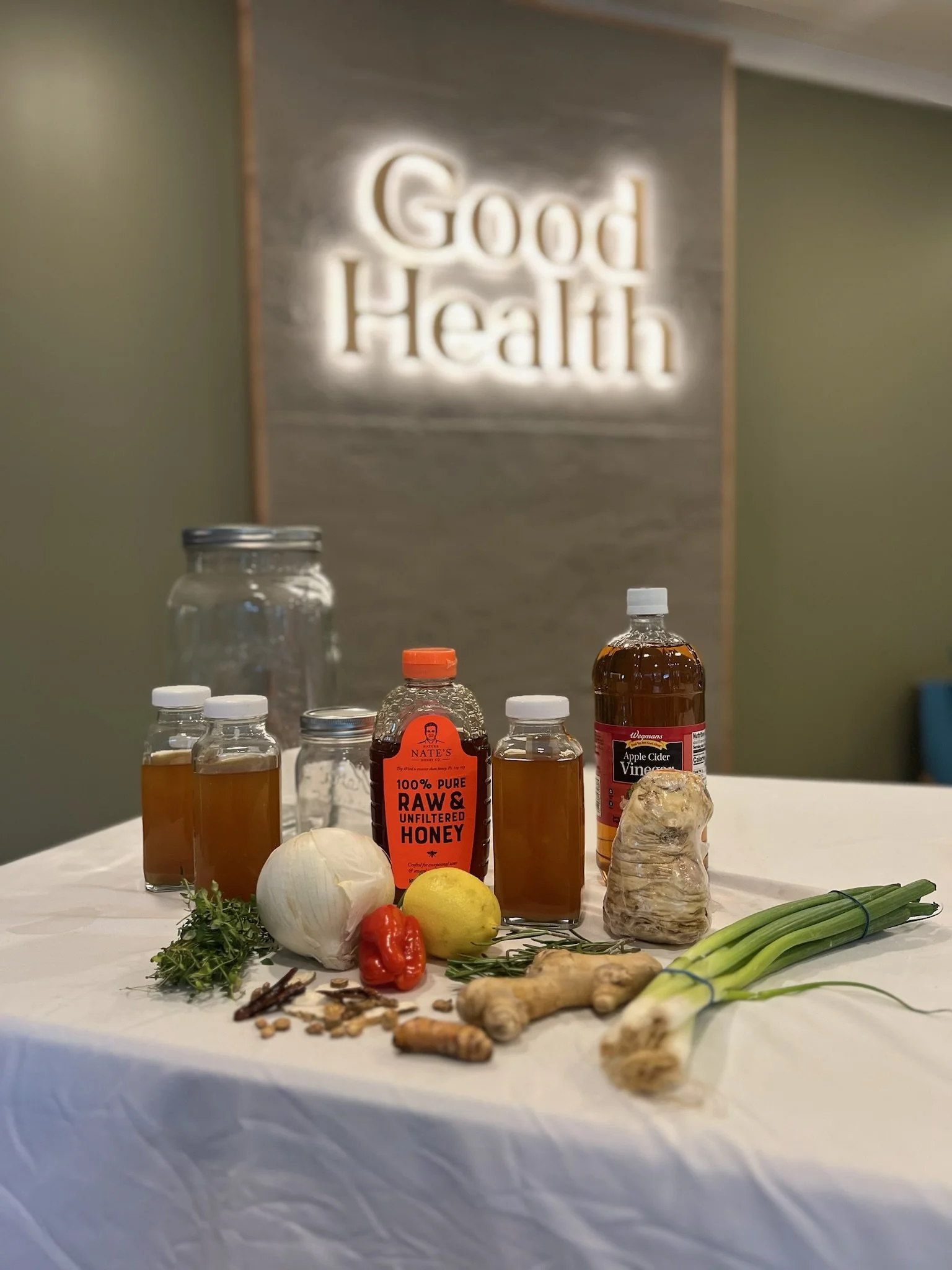Fire Cider Recipe - 2025
August is the time to start your fire cider
If you joined us for last year’s Fire Cider Making Class, you’ll remember that now—late summer—is the perfect time to start your batch so it’s ready to go for autumn and winter’s cold and flu season. Fire cider is a traditional herbal tonic packed with immune-supportive ingredients, and it needs several weeks to cure for maximum potency. Look below to find this year's recipe, a unique blend based on the anticipated signs and symptoms of this year. All herbs are available through the Good Health herbal dispensary. Start your batch now, and you’ll be ready with a warming, immune-boosting tonic when the chilly months arrive.
Fire Cider Recipe
¼ cup peeled and grated Horseradish:
Antibacterial properties
Effective against both Gram-positive and Gram-negative bacteria. Prevents bacterial infections in the respiratory tract and urinary tract.
Clears mucus, helping with respiratory infections and reducing biofilms, a bacterial safehouse
Rich in vitamin C, supporting immune function
¼ cup peeled and diced Garlic:
Strong antimicrobial and antiviral properties
organosulfur compounds such as allicin, diallyl sulfide, and ajoene
Contains allicin, which boosts white blood cells to fight infections
Supports gut health, enhancing immune response
¼ cup peeled and diced Onion:
Contains quercetin, a powerful antioxidant
Anti-inflammatory and antimicrobial effects
Supports respiratory health and reduces cold symptoms
¼ cup peeled and grated Ginger:
Helps reduce oxidative stress and supports immune defense
Eases nausea and supports digestive health
⅛ cup peeled and grated Turmeric:
Contains curcumin, which has strong anti-inflammatory and antioxidant effects
Boosts immune system by enhancing the activity of immune cells
Suppresses the production of pro-inflammatory cytokines (e.g., TNF-alpha and IL-6), present with chronic inflammation.
Acts as an antioxidant, neutralizing free radicals
½ Habanero Chile:
Rich in vitamin C, enhancing immune response
Contains capsaicin, which has antibacterial and anti-inflammatory effects
¼ sliced Orange:
High in vitamin C, which is crucial for immune function
Provides antioxidants to help neutralize free radicals
¼ sliced Lemon:
High in vitamin C and antioxidants
Supports detoxification and boosts immune health
⅛ cup chopped Parsley:
Rich in vitamins A, C, and K
Contains flavonoids, supporting immune and anti-inflammatory functions
⅛ cup chopped Rosemary:
Contains antimicrobial compounds that help fight infections
Rich in antioxidants to support overall immune health
⅛ cup chopped Thyme:
Rich in vitamin C and antioxidants
Supports respiratory health
1 tsp Black Peppercorns:
Contains piperine, which boosts nutrient absorption, including curcumin from turmeric
Anti-inflammatory and antimicrobial properties
Huang Qi (Astragalus)
Boosts Immune Cell Function: Astragalus is known for enhancing the activity of immune cells, including macrophages, T-cells, and natural killer cells which identify viral pathogens
Stimulates the production of antibodies, which help the body respond more efficiently to infections
Bai Zhu (Atractylodes)
Enhances the activity of white blood cells, which helps the body fight off infections.
Supports the spleen, an organ in Chinese medicine that regulates digestive health.
Inhibits biofilms, the substance that bacteria use to gain resistance within the body.
Fortifies Wei Qi, the body's defensive energy. Wei Qi acts as a barrier to external pathogens
Fang Feng (Saposhnikoviae)
Enhances the immune system's ability to fight off pathogens
Often used in TCM formulas to prevent and treat upper respiratory infections
Chai Hu (Bupleurum root)
Contains saikosaponins, which show anti-inflammatory, immunomodulatory, and antiviral properties—helping regulate cytokine responses and potentially reducing fever.
Demonstrated activity in modulating the hypothalamic–pituitary–adrenal (HPA) axis and immune balance, which may support recovery from viral infections.
Ban Xia (Pinellia tuber)
Traditionally used to reduce phlegm, nausea, and congestion; modern studies show antitussive and antiemetic effects, making it useful for respiratory tract symptoms.
Exhibits anti-inflammatory and antiallergic activity, helping to calm airway irritation and excessive mucus production.
Gui Zhi (Cinnamon Twig)
Contains cinnamaldehyde and cinnamic acid, which display antiviral, antimicrobial, and vasodilatory effects, supporting circulation and alleviating chills/aches.
Shown to enhance immune cell activity and exert antipyretic (fever-reducing) properties, relevant in early cold/flu stages.
Ren Shen (Ginseng root)
Rich in ginsenosides, which enhance immune cell (NK cell, macrophage, T-cell) activity, supporting resistance against viral respiratory infections.
Clinical and experimental studies suggest it can shorten duration and reduce severity of colds/flu, partly by modulating inflammatory responses and boosting mucosal immunity.
Fill mason jar with ingredients and add Raw Unfiltered Apple Cider Vinegar (at least 5% acidity):
Contains beneficial probiotics and acetic acid, which support gut health and immune function
Antimicrobial properties that help fight harmful bacteria
Raw Honey to taste (after brewing completed):
Rich in antioxidants
Antimicrobial and antibacterial properties
Soothes throat and boosts immune response
Building a strong foundation of health allows us to see beyond the valleys



